Psychologists say it takes us only one-tenth of a second to form an impression of a stranger. While I couldn’t find any research as to how long it takes to form a first impression of a cookbook, my experience is that it’s quick. I lift recipe books off shop and library shelves, flick through them, and instinctively I know which ones I’ll never use. Others – based on their combination of layout, colour, design and mouthwatering photos – I’m immediately drawn to. To me, the best cookbooks are also objects of beauty.
At the same time, a cookbook must be more than mere eye-candy. As Nigella Lawson writes in Cook, Eat, Repeat, “a recipe is worthless if it’s not reliable”. So when I decided to write a cookbook of Indian-Jewish food, based on my family’s traditional cuisine, I knew a dual challenge lay ahead: to ensure the recipes were clearly written, easy-to-follow, and reliable, and to create a visually appealing book. I needed help! Specifically, I needed a food photographer and food stylist who could bring my vision to life.
First though, I had to learn to cook the dishes made by the women in my family and community, and to document the recipes. Recipe-writing, I soon discovered, is a very specific form of technical writing, which requires incredibly close attention to detail. I agonised over minutiae as I wrote lists of ingredients: should it be ground cumin or cumin powder? Beef mince or minced beef?
A seemingly innocent cinnamon stick also caused me grief. I’d initially listed an ingredient in my recipe for pilau (yellow rice withs spices) as 1 cinnamon stick, approx. 8 cm long. Months later, my husband was cooking pilau in our kitchen and I watched him add an entire cinnamon quill to the pot – which was much more than the small piece I’d intended! I realised that what I call a ‘cinnamon stick’ (based on my family’s use of the word) is actually called cinnamon bark. I to-ed and fro-ed over the wording, finally settling on: 1 cinnamon stick, broken into an 8cm x ½ cm piece.
Writing the cooking method for each dish was similarly challenging. For example, I deliberated over whether an onion needed to be cooked until soft or until it had softened. (They sound the same, but there’s a slight difference.) And I couldn’t decide whether or not to include information about the size of the pot or saucepan I’d used. Given that pot size impacts cooking time, I eventually decided that information would be helpful to readers. So my recipe for cauliflower and potato bhaji (a dry curry) includes this sentence: I use a sauté pan with a 28cm diameter. One of my proofreaders, the co-author of numerous cookbooks, changed the sentence to an instruction: Use a sauté pan with a 28cm diameter. But as much as I wanted to provide clarity, I didn’t want to be bossy. I reverted to my original version, feeling that I’d finally found my cookbook writing voice.
Once I’d mastered the cooking of each dish, it was time for the photoshoots. Had I been able to secure a publishing deal, I imagine the publisher would have had nominated a food photographer and stylist. I did pitch my concept and some sample recipes to Murdoch Books early on, knowing that it was unlikely they’d say yes: I’m not a chef and I don’t have a restaurant or a large social media following. In the end, my book was published by the Sydney Jewish Museum, but it was up to me to find a photographer. And I had my heart set on finding an Indian food photographer (a very particular ask, I know, but I wanted someone familiar with Indian culture and cuisine).
Thanks to Google, I eventually found Shibani Mishra, a professional, Indian-born food photographer. As an added bonus, Shibani also had food styling experience. This was a huge win, as I discovered there’s a strict hierarchy between food photographers and stylists: as a general rule, food photographers only snap; they don’t style.
I’d been warned by another cookbook author that the photoshoot days are “full on.” She was right: I had four days of shoots, with eight dishes to be captured per day. And those shoots had to be organised with military precision. Shibani created a Google document in which I shared a photo of each dish, taken on my phone, so she could visualise the finished product. Next, she added some reference images with different ways she could style the food. For example, for the chapati (Indian flatbread) recipe, one option was to have the chapatis stacked on a wooden board; another was to have them folded in half atop a colourful plate, with a rolling pin in the background. Then we spoke by phone to decide on the styling and choose the crockery, cutlery and backdrop for each shot. And I still had all the cooking to do!
In advance of each shoot, I listed the eight dishes in the order which Shibani planned to photograph them. In the days leading up to the shoot, I shopped for ingredients and identified what could be cooked in advance. Biscuits, for example, could be baked and frozen, and curries could be prepared the day before. But many of the recipes, such as the chapatis, pilau, egg mahmoosa (scrambled egg with vegetables) and zalata (chopped salad) had to be made fresh. I prepped as much as I could the night before each shoot; filling my fridge with Glad-Wrapped bowls of chopped onion, tomato and cracked eggs, and measuring out exact quantities of rice and spices. On the upside, there was plenty of delicious food in my house after each shoot.
When it came to the interior of the book, it was like planning a wedding as there were endless decisions to make: how to lay out the recipes? Which font to use? Should the photos have borders around them, and if so, how wide? What paper weight did I want for the pages? Should the book be hardcover, soft cover or flexibinding?

And now, after much agonising over all those decisions, Indian-Jewish Food: Recipes and Stories from the Backstreets of Bondi is out in the world. “It’s a beautiful book”, many people have told me, which fills me with joy, as well as with gratitude to Shibani and to my designer, Kim, who created a book even lovelier than I could have imagined. But of course, it’s not enough for a cookbook to look beautiful.
A photo of the final dish certainly helps readers visualise what they’re aiming to create. But absent step-by-step photos (which most cookbooks don’t have, due to space and budget constraints), it’s the author’s words which must convey exactly what they’ve done in their kitchen, so readers can replicate it in theirs. Even – perhaps especially – in a cookbook, every word counts.
Elana Benjamin is a freelance writer and home cook. Her writing has been published widely, including in Good Weekend, Sunday Life, the Sydney Morning Herald, SBS Voices, Essential Kids, The Jewish Independent, Kveller and Tablet Magazine. Elana is also a contributor to Growing Up Indian in Australia (2024, Black Inc.), and the author of My Mother’s Spice Cupboard: A Journey from Baghdad to Bombay to Bondi (2012, Hybrid Publishers). Elana holds an Arts/Law degree with a history major from the University of New South Wales. She lives in Sydney with her husband and their two children.


I love cooking and eating almost as much as I do reading and writing. I can’t pass a bookshop without perusing their cookbook section and, like Elana, I too know almost immediately which ones are filled with recipes I will use and which I are not. I was so interested in the minutaie of the decision-making that goes into creating a cookbook. So many tiny but important details to consider! Thanks for sharing that with us. Where can I get a copy of the book?
Dear Jodie, I’m glad you share Elana’s (and mine :)) love for cookbooks! Thank you for your lovely response. I’ll let Elana to answer your question.
Hi Jodie
Thanks so much for your lovely words. Yes, when I first conceived the idea of writing a cookbook, I had no idea of all the tiny details that would be involved!
Thanks also for your interest in book. My website, elanabenjamin.com, has details of where you can get a copy. Happy reading, cooking and eating!
Warmest
Elana